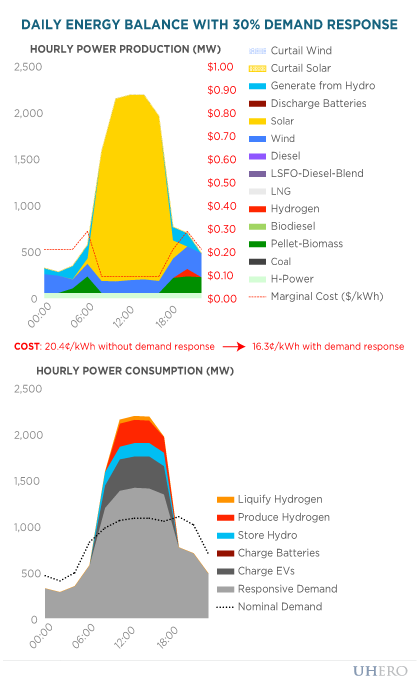By Michael Roberts
*This post follows up on the previous post in the Sustainable Energy Blog Series: Four Years to Improve Renewable Energy.
HECO has recently proposed new time-of-use rates and is developing pricing for various kinds of demand response programs. The proposed programs are a long ways from the open-access, marginal-cost pricing, but they are a big step in the right direction.
Table 1. Proposed Time-of-Use Rates in Hawai`i (cents per kilowatt-hour)
| Mid-Day 9am – 4pm | On-Peak 4pm – 12am | Off-Peak 12am – 9am | |
| Hawaiian Electric (Oahu) | 11.0413 | 36.1997 | 13.6755 |
| Hawai`i Electric Light (Big Island) | 15.7148 | 46.3867 | 17.8685 |
| Maui Div. of Maui Electric | 23.8116 | 45.7002 | 26.8383 |
| Lanai Div. of Maui Electric | 36.6396 | 52.3616 | 35.7913 |
| Molokai Div. of Maui Electric | 36.6396 | 52.8520 | 29.6548 |
The new time-of-use rates embody high-powered incentives for shifting loads to different times of the day (Table 1). Depending on an individual household’s use profile, many should be able to reduce their bills even if they don’t change the way they use electricity. Alternatively, some households might be tempted to install batteries, charging with solar or cheaper electricity during the daytime and discharging during nighttime peaks. Such strategies should be economical given these price differentials.
Unfortunately, these rates only apply to residential customers, which is a small share of the load (about 27%). To maximize load shifting potential and make use of real time meters already in place, we should quickly introduce variable prices for commercial-scale customers.
While time-of-use pricing is a step forward, the proposed time-of-use prices, despite their apparent 4-digit precision, do not reflect the true incremental cost of electricity. The true cost can vary significantly across hours in each block in the table of proposed rates, and across different days and seasons of the year. Expensive peak loads, for example, fall off sharply by 9pm, but peak-load pricing extends until midnight. Also, the difference between peak pricing and midday pricing far exceeds the current cost of serving these loads. Values are likely to change rapidly as the generation mix shifts increasingly toward renewables, so it appears that proposed prices anticipate future changes in generation. While the incentives are strong enough to kick-start demand response programs, it’s hard for customers to know how the rate structures will change over time. The uncertainty could discourage entrepreneurs looking to Hawai`i as a place to test their demand response technologies.
Over time, variable pricing could be improved in a number of ways. First, it is important to make the price-setting mechanism clear and transparent, so that customers and entrepreneurs developing smart devices can reasonably anticipate how prices will change going forward. The guiding mechanism should link to the overall system’s marginal cost of electricity. Second, customers should be given more choices. Some may prefer time-of-use pricing with the proposed simple three-block structure; others might embrace full-fledged real time pricing; others may prefer something in-between. As long as rates reflect typical costs in each block, customers will be free to choose a level of flexibility they are comfortable with.

Source: “Making an Optimal Plan for 100% Renewable Power in Hawaii“
How much will the new rates shift loads away from the peak and toward midday and early morning? The reality is that it’s very hard to know. In fact, it will still be difficult to know even after new rates have been implemented. Many households could probably select time-of-use pricing and save money without shifting loads at all. We won’t be able to tell whether they always tended to use electricity during the low-cost times or changed behavior as a result of time-of-use pricing. To know, it is important to observe real-time electricity use before and after the rate change. And we would further need to rule out the possibility that other factors besides the rate change were affecting use.
To accurately measure how much demand-response bang for the time-of-use buck the system is getting from variable rates, or any other change in policy, we need to run actual experiments. The idea is to offer up different pricing menus to different households and businesses for a trial run of a year or two. The pricing menus would need to be randomly assigned across customers, in part for fairness, but also to ensure that observed changes are not a reflection of selection bias. Some households might obtain opportunities to install smart devices that aid automatic shifting of loads. Some randomly selected customers would be reserved as controls, without the opportunity to choose a variable pricing contract. Such experiments could measure the actual and potential demand response much more precisely than simply changing policy for everyone all at once.
Of course, the public would need to be let in on the whole policy experiment. And it would further help to have some guidelines for how policy will evolve based on the outcomes of the experiments. There are a number of successful examples of such experiments, some of which show great potential for curbing peak loads, and customers that are happy participating in the program. While we can learn from policy experiments elsewhere, the load shifting needed in Hawai`i is different and more substantial. We need our own, thoughtfully-designed experiments to learn the true potential for demand response.
BLOG POSTS ARE PRELIMINARY MATERIALS CIRCULATED TO STIMULATE DISCUSSION AND CRITICAL COMMENT. THE VIEWS EXPRESSED ARE THOSE OF THE INDIVIDUAL AUTHORS. WHILE BLOG POSTS BENEFIT FROM ACTIVE UHERO DISCUSSION, THEY HAVE NOT UNDERGONE FORMAL ACADEMIC PEER REVIEW.